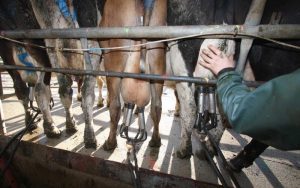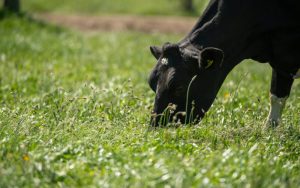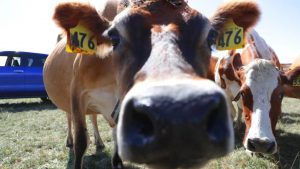
With the dust settling in the wake of New Zealand and the European Union revealing a free trade agreement had been landed after years of deliberation, the opportunities for dairy export growth need to be reimagined.
In the lead up to the EU deal being finalised, some industry advocates were arguing a favourable deal was essential for NZ to ensure the value of our dairy exports could keep growing. What was negotiated, however, was widely acknowledged to be ‘unfavourable’. Does this mean all hopes for growing the value of what we produce have been dealt a fatal blow? The answer is likely no, but it might mean we’ll have to work harder to achieve it.
Recently back from the bargaining table, New Zealand’s chief negotiator for the FTA with Europe, Vengalis Vitalis spoke at the Primary Industries Summit in Auckland, and called for those upset by the paucity of sweeteners for dairy to take stock of the wider market reality. Vitalis openly accepted the gains from the deal were miserly and expressed frustration at that. But the context was also important. He noted that NZ is the only market other than the United Kingdom that has preferential access on dairy.
While quotas will still limit the extent that dairy exports can grow, the near elimination of tariffs over seven years will mean some butter (36,000 tonnes) will be able to enter with a tariff of 95 euros per tonne, down from 770 euros.
The fact that this has been afforded to other markets beyond the UK sounds like cold comfort, but the reality is NZ will have an edge on others. For example, Mercosur (the South American bloc of countries including Argentina, Brazil, Paraguay, and Uruguay) had negotiated 30,000t of cheese quota in its deal (which is currently floundering and won’t be ratified anytime soon) but with tariffs phased out over 10 years. NZ secured 31,000 tonnes of quota that goes to zero tariff on day one.
Among the other reality checks we need to consider are how European dairy producers felt about the deal. Vitalis noted the European Fed Farmers equivalent, Copa-Cogeca responded by saying EU dairy farmers had been sacrificial lambs and they had paid a very high price. Almost comically, they argued the new access NZ dairy products had obtained will increase market pressure on European production. If the prospect of the very occasional baguette being slathered with NZ butter does induce sleepless nights, it’s hard not to conclude they’re still on a reasonable wicket.
All that said, everything is relative.
We might wish to ignore it, but recent legislative changes in Europe have compelled farmers to make radical adjustments to their operations, which will undoubtedly impact on their productive capacity. Over the past couple of years, the Netherlands, for example, has introduced a 13-year plan to significantly reduce livestock numbers to address nitrogen problems. This plan also involves initiatives to prompt farmers to leave the industry. Any further imposition, however minor in impact is likely to add fuel to EU farmers’ sense of struggle.
It’s possible to say that European farmers’ blight in this regard is no different to that being experienced by their NZ counterparts. But again, that won’t have forced them to think of us as comrades in arms.
Interestingly though, the deal implies just that, via the joint commitment to the principles of sustainability. Both the EU President Ursula von der Leyen and NZ trade minister Damien O’Connor made a point of highlighting a clause that states neither party will deviate from the Paris Accord for climate change for trade advantage.
The EU President said it was a first for a trade deal to include sanctionable commitments to the Paris Climate Agreement, while O’Connor made the unsubtle point that NZ would be taken to task if it strayed off its stated climate obligations. For Vitalis, this represents a reassuring outcome in that NZ would be able to raise concerns about the impact on prices of European environmental subsidies in a legally binding way. Furthermore, one of the reasons the Mercosur FTA with the EU has run into problems in the pre-ratification process is that a commitment to reducing its environmental footprint is out of alignment with the EU’s. With NZ sharing the EU’s goal, our goods should have more appeal.
Equally though, there’s justification to be cynical about the EU’s apparent respect for the efforts NZ is making to de-carbonise its economy. Proper respect would have meant NZ dairy products being afforded fairer access. As DCANZ said in its assessment, “The EU has largely rejected the opportunity to provide its own consumers with access to NZ dairy products that have considerably lower carbon footprint. New Zealand dairy farmers will be disappointed that their considerable efforts in adopting onfarm sustainability practices are not able to gain the extent of market recognition they deserve under this outcome.”
It would be nice to think European consumers would have the ability to reward NZ farmers for this, but with the quotas set for cheese and butter, there’s very few consumers who will have an opportunity to do so. DCANZ added a stark reminder of the market imbalance where the EU has about 15% share of the NZ domestic dairy market, but NZ would only have about 0.14 percent of the EU market.
With that sobering reality in mind, what now are the opportunities for NZ to achieve export growth?
With the EU deal concluded, suggestions have been made that for the time being at least, there’s not much more we should expect to see in free market access. The government has pointed to opportunities that will arise if NZ was to gain associate membership of the Pacific Alliance (Mexico, Peru, Colombia and Chile). Colombia is said to be a noteworthy importer of dairy products. Elsewhere access could be improved by advancing the FTA with the Gulf Cooperation Council, which would create a level playing field for exporters.
On the face of it, this suggests there are now limited prospects for the NZ dairy industry to grow its exports. Not only that, but the charge also to transition from ‘volume to value’ (which is fundamentally where NZ must go with milk production having peaked) is challenged with the highest value markets (EU, together with the United States) either marginally accessible or inaccessible. However, that presumes accessing high value markets is simply based on increasing rules-based free access on a country-by-country basis. Obviously, those conditions enable growth by the easiest means. What we probably need to come to terms with is there remains plenty of opportunity to capitalise on high value markets within countries that NZ has existing free trade deals with – but they are niche and will require more effort.
It’s also worth reflecting on NZ’s existing competitive advantage in the trade of dairy products, where we are closer to the world’s key growth markets than our rivals. The EU has tended to push its surplus output down into the Middle East and Africa, and excess production in South American markets has tended to fill gaps within the region itself. But those markets have not been high growth or high value, unlike Asia, and specifically China where NZ still commands a head start with an existing trusted relationship.
Yes, you never want all your eggs in one basket. To some extent that has been the reason many felt the EU deal has been a particularly sore loss, with government regularly nudging exporters to diversify away from a reliance on China. But you also need to focus on where the growth is, and despite potential geopolitical tension, China and Asia is where growth opportunities remain. There’s no point ignoring that – other market producers will be more than happy to fill the void. ANZ agricultural economist Susan Kilsby says this will require a turnaround in our thinking, which means identifying niche groups of premium consumers within existing markets and responding to their needs.
“To some extent we do that anyway. Fonterra has long supplied Nestle with ingredients that give consumers what they want. But there will be more demand for products to be produced in a way that will command more value. At the moment there is an information gap, where market information doesn’t necessarily flow back to the farmgate. But some suppliers are being linked in through processors to give consumers something extra.
“Synlait and Miraka have identified this and are meeting specific market needs on a smaller scale. Fonterra will eventually do this on a much bigger scale.”
The hurt over the missed EU opportunity won’t disappear overnight, but to move forward we can’t afford to dwell on being locked out of a geographical market. Rather we need to dwell on what it takes to be locked into high-value markets within markets, wherever they may be.
























